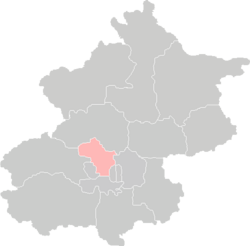Haidian District
|
Haidian 海淀区 |
|
|---|---|
| District | |

Haidian District
|
|
 Location of Haidian District in Beijing |
|
| Coordinates: 39°54′N 116°18′E / 39.900°N 116.300°ECoordinates: 39°54′N 116°18′E / 39.900°N 116.300°E | |
| Country | People's Republic of China |
| Municipality | Beijing |
| Township-level divisions | 22 subdistricts 5 towns 2 townships |
| Area | |
| • Total | 431 km2 (166 sq mi) |
| Population (2010) | |
| • Total | 3,281,000 |
| • Density | 7,600/km2 (20,000/sq mi) |
| Time zone | China Standard (UTC+8) |
| Postal code | 100080 |
| Area code(s) | 0010 |
| Website | bjhd |
Haidian District (simplified Chinese: 海淀区; traditional Chinese: 海淀區) is a district of the municipality of Beijing. It lies towards the northwestern part of the urban core.
It is 431 square km in area, making it the second-largest district in urban Beijing (after Chaoyang), and is home to 2,240,124 inhabitants (2000 Census); however, in comparison to other districts, a higher percentage of its inhabitants do not have the governmental residential certificates for long-term residence, because Haidian District is where most universities are located and therefore many of its inhabitants are college students.
Since 1992, Haidian District has signed official papers and established Sister City relationship with 14 cities and districts from 10 countries of 4 continents. Some sister cities are shown below:
South America
North America
Europe
East Asia
The administrative division of the district was reported as follows:
Haidian was originally a village outside of Beijing's Inner City. It was first built in the Yuan Dynasty and became one of the eight major business areas of the capital during the Qing Dynasty and was the seat of such old shops as Lotus White, Quanjude and Hongbin House. The famed Old Summer Palace and Summer Palace, two grand imperial gardens are also among its reputed features. It became a university district after the building of the Tsinghua University and Yenching University campus in the early twentieth century. It is mentioned in Lao She's novel Camel Xiangzi as an academic village for students. After the foundation of the People's Republic, it was deliberately developed as a university area, with many of the Yan'an institutions moving there. It officially became an administrative district in June 1954. Since the reform and opening up, it has become the centre of China's IT industry. In the words of Time magazine:
...
Wikipedia
